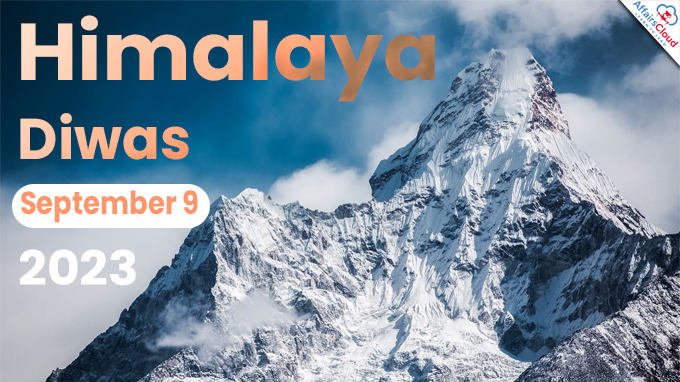 Himalaya Diwas, also known as the Himalayan Day is annually observed across India, especially in the state of Uttarakhand on 9th September with the aim of conserving the Himalayan ecosystem and region.
Himalaya Diwas, also known as the Himalayan Day is annually observed across India, especially in the state of Uttarakhand on 9th September with the aim of conserving the Himalayan ecosystem and region.
- The day also aims to raise awareness among the general public and bring community participation in conservation activities to save and maintain the Himalayas and mountain nature.
9th September 2023 marks the 14th edition of Himalaya Diwas.
Background:
i.Himalaya Day, initiated on September 9, 2010, was a significant step towards acknowledging the importance of the Himalayan region. While the government initially expressed interest in this attempt, progress on the matter has been slow.
ii.In 2014, Harish Rawat, the then Chief Minister (CM) of Uttarakhand officially declared the 9th September of every year as the ‘Himalaya Diwas’.
- He also announced that the day would be celebrated by the Government of Uttarakhand as well.
iii.In 2015, Harish Rawat officially declared government recognition for Himalaya Day, following a proposal by Ajay Bhatt, a senior BJP leader and the Leader of the Opposition.
iv.The first-ever Himalaya Diwas was celebrated on 9th September 2015.
Significance:
i.The day is celebrated to tell the importance of the Himalayas, often referred to as the “Mountain King“.
ii.Himalaya Day is celebrated to stop indiscriminate exploitation of the region’s natural resources, deforestation, shrinking glaciers, river depletion, and pollution reaching the Himalayas under any circumstances.
About the Himalayas:
i.The name of the mountain range, Himalaya, originally came from the world Himā-laya, which means ‘Abode of Snow’ in Sanskrit.
ii.It is a spectacular range of mountains located in the subtropical high-pressure belt region of the Earth, encompasses parts of eight South Asian territories of Afghanistan, Pakistan, China, India, Nepal, Bhutan, Bangladesh, and Myanmar (Burma).
iii.Running from west-northwest to east-southeast, the crescent-shaped Himalayan range is 2500 kilometers long, with the western anchor in Nanga Parbat and the eastern anchor in Namcha Barwa.
iv.The northern Himalayas is bordered by the Karakoram Mountains and the Hindu Kush Mountains.
Peaks:
i.The Himalayas is the highest mountain range in the world and has 9 out of 10 of the world’s highest peaks, including Mount Everest, which is the highest of the Himalayas mountain.
ii.The 10 peaks exceeding 8000 meters in elevation in the Himalaya ranges, namely Mount Everest (~8848 meters), Kangchenjunga (~8586 meters), Lhotse (8516 meters), Makalu (8485 meters), Cho Oyu (8281 meters), Dhaulagiri (8167 meters), Manaslu (8163 meters), Nanga Parbat (8126 meters), Annapurna (8100 meters), Shishapangma (8064 meters).
iii.These mountains, referred to as the Third Pole, are the source of some of Asia’s major rivers and also help to regulate the planet’s climate.
- Moreover, there are 40 mountains over 7000 meters above sea level. That’s why the Himalayas is the highest mountain range on Earth.
Flora and Fauna:
i.The Himalayan region, with its diverse climatic conditions, is home to many uncommon, endemic, and endangered species of flora and fauna.
ii.The number of plant species in the Himalayas is estimated at 25,000, 10% of the world’s known species, and 50% of India’s endemic flora.
iii.The Great Himalayan National Park (GHNP) itself boasts 832 plant species, representing 128 families and 427 genera, and comprising 26% of the total flora of Himachal Pradesh.
Some UNESCO World Heritage Sites in the Indian Himalayas:
- Darjeeling Mountain Railways (Darjeeling Himalayan Railway), West Bengal- (Cultural UNESCO World Heritage Site in 1999).
- Nanda Devi & Valley of Flowers National Parks, Uttarakhand (Natural UNESCO World Heritage Site in 1988).
- Khangchendzonga National Park, Sikkim (First site in India of Mixed UNESCO World Heritage Site in 2016).
- Manas Wildlife Sanctuary, Assam (Natural UNESCO World Heritage Site in 1985).
- Great Himalayan National Park Conservation Area (GHNPCA), Himachal Pradesh (Natural UNESCO World Heritage Site in 2014).
2023 Events:
i.The 14th edition of Himalaya Diwas was observed on 9th September 2023, at Gandhi Park, Dehradun (Uttrakhand), where environmental groups organised a ‘Himalaya aur Hum’ rally and other programmes.
- The 2023 celebrations focused on escalating Himalayan disasters through songs, discussions, and debates.
ii.Padma awardee Dr. Anil P. Joshi, founder of the Himalayan Environmental Studies and Conservation Organisation (HESCO) emphasised the need for “Sustainable development methods,” to protect the Himalayas.
iii.On September 9, 2023, Pushkar Sigh Dhami, CM of Uttarakhand greeted the people of Uttarakhand, on Himalaya Day and emphasised the Himalayas as the basis of water, life and environment.




